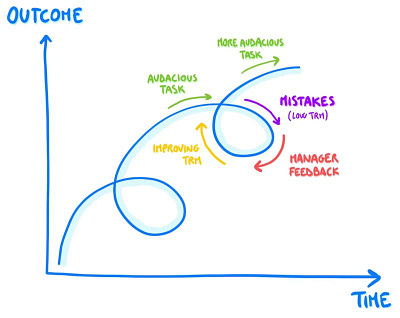The app for independent voices
Wonder why some team members need more guidance than others? Spoiler: it's not about skill.
In his landmark book High Output Management, Andy Grove introduced the idea of 𝘁𝗮𝘀𝗸-𝗿𝗲𝗹𝗲𝘃𝗮𝗻𝘁 𝗺𝗮𝘁𝘂𝗿𝗶𝘁𝘆, capturing an employee's readiness to shoulder responsibility.
Grove dissects TRM into several factors, but let's focus on the two key ones:
🎓 𝗦𝗸𝗶𝗹𝗹/𝗙𝗮𝗺𝗶𝗹𝗶𝗮𝗿𝗶𝘁𝘆 — the employee's expertise and readiness for the task.
📋 𝗖𝗼𝗻𝘁𝗲𝘅𝘁 𝗤𝘂𝗮𝗹𝗶𝘁𝘆 — how robust and well-documented your standards are.
Both items are crucial.
Say you need to create a design doc around a new product feature. You may have the best engineer in the world, who has done hundreds of them in their career, but they still need context from you:
✔️ 𝗧𝗮𝘀𝗸-𝘀𝗽𝗲𝗰𝗶𝗳𝗶𝗰 — what tradeoffs should they consider? What about speed and scale?
🔭 𝗣𝗿𝗶𝗻𝗰𝗶𝗽𝗹𝗲𝘀 — what do design docs look like on our team? How do you plan rollouts and rollbacks? How is the code instrumented?
The right amount of management depends on the level of TRM:
🔴 𝗟𝗼𝘄 𝗧𝗥𝗠 — your team hasn't done this before, and there's no existing procedure. Provide detailed instructions, pair regularly, and maintain a close feedback loop. Don't let them work too long without your input; correct often and update the procedure with your feedback.
🟡 𝗠𝗲𝗱𝗶𝘂𝗺 𝗧𝗥𝗠 — your teammate has completed similar tasks before and knows what good look like, thanks to experience and/or good docs. Provide clear context about the goals, then allow them the freedom to execute.Keep communication lines open to offer support as needed.
🟢 𝗛𝗶𝗴𝗵 𝗧𝗥𝗠 — your teammate has completed plenty of similar tasks in the past, with good results. In this case, other than giving full autonomy, you can challenge them to improve the definition of good. What can we do better?

